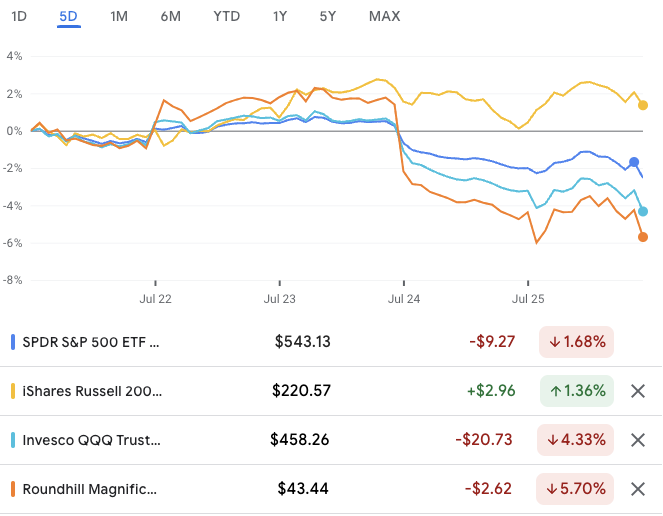What a Week! t has been a long time since we have seen such volatility in the markets. The VIX, a measure of volatility in the S&P 500 index, has climbed to 18.04, the highest since April 2024.
Last week, I discussed the potential rotation from growth to value and from large caps to small caps, and this trend has persisted this week.
The “Magnificent 7” (MAGS) declined by 5.7% this week, dragging down the Nasdaq 100 (QQQ) and the S&P 500 (SPY) by 4.3% and 1.7%, respectively. Meanwhile, small caps, represented by the Russell 2000 (IWM), have risen by 1.4%.

Comparing the S&P 500 Growth (IVW) with Value (IVE), both have declined, but IVE dropped less, by just 0.8%, while IVW saw a bigger drop of 2.7%. The winners are small caps once more, with the Russell 2000 Value (IWN) outperforming its growth counterpart (IWO), gaining 1.8% compared to IWO’s 0.4% gain.

We should view this positively rather than negatively. The dominance of Big Tech has been overdone and overdue for a correction. Investors have been complaining about the lack of a broad market recovery, and now we’re finally seeing it. As the leaders wane, the laggards are rising, leading to a more balanced and healthy market environment. The S&P 500 has had a fantastic run since the start of 2023, and the recent drop is just a blip. Yes, the index may fall further, but the long-term uptrend remains intact, as indicated by the index staying above its 200-day moving average (red line). A pullback is necessary for healthy market movement.

If we zoom out to look at the different performance periods between the Big Cap S&P 500 (SPY) and the small cap Russell 2000 (IWM), we can see that the outperformance of Big Caps remains significant, at 38% higher than the small caps. What we are seeing is just a mean reversion effect, and it is healthy for the broad market to rise together, narrowing the gap.

Another piece of good news is that US economic growth came in stronger than expected, with GDP for 2Q24 rising by 2.8%, higher than 1Q24’s 1.4% and the expected 2.1%. Yet, this has not affected the probability of a rate cut in September, as the market still expects an 88% chance of the Fed cutting rates by 0.25%.
Looking at sectors and themes of big movers, one pattern we can identify is that ‘old’ industries like banking, defense, and healthcare are performing better, while ‘new’ industries such as tech and semiconductors are lagging. This is consistent with our earlier discussions.

Commodities, on the other hand, present a mixed bag. Natural gas and corn have gained more than 3% in a week, while oil, uranium, silver, and rare earths saw prices plummet by more than 4%. These movements are likely driven by supply and demand dynamics rather than being indicative of inflation or deflation.
Overall, the picture is that consumption is reducing, and the economy is weakening, as evidenced by the strong performance of essential industries while consumer discretionary has done poorly.
This picture contrasts with the good economic growth recorded in 2Q24. Lest we forget, the stock market is a leading indicator, while GDP numbers are historical and hence lagging. This suggests that we may expect the US economy to weaken in the second half of this year, providing a reason for a rate cut in September.
I continue to hold the view that the first rate cut may not be good for the markets, and stocks may experience a roller coaster ride in the next two months. Traders will have their work cut out for them. But for long-term investors, this period might be a good time to be more attentive and pick up good deals if any.

